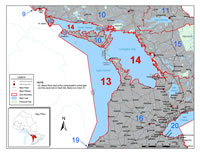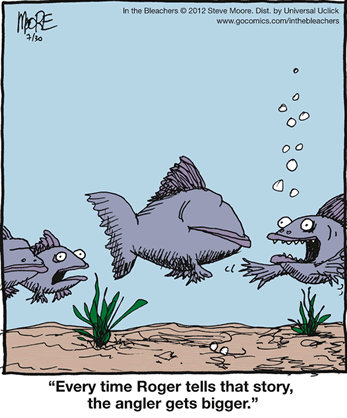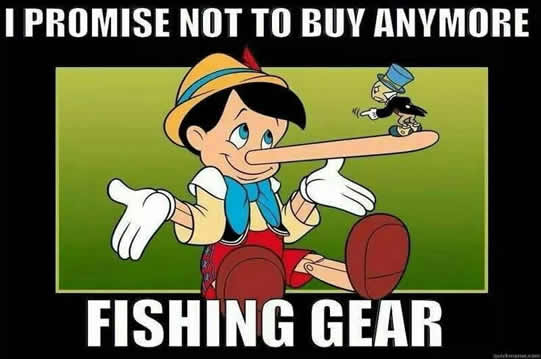The Fishing
Fishing License: If you are 18 years of age or older, an Ontario Fishing License and Outdoors Card are required to fish in Ontario. The easiest way to purchase them is online from this website. You'll have to establish an account with them, which only takes a minute or so. Licenses can also be purchased at most Canadian Tire stores, participating ServiceOntario Centres, the Cabela's in Barrie or at the hardware store next to the Foodland in MacTier. The Bass Pro Shops in Toronto is another place to buy your license. It's located at the first exit after ETR 407 joins 400 northbound (Exit #32, Bass Pro Mills Drive). The store doesn't open until 9 AM on Saturdays and 10 AM other days.
The Outdoors Card is valid for three years. Fishing licenses may be purchased for eight day, one year or three year periods. If you will not be keeping your catch, you can save some money by buying the Conservation license which has lower catch and possession limits than the more expensive full fishing license. Here is another page where you may view and download the Ontario fishing regulations and learn other good stuff.
 Fisheries Management Zones: The PA Club is located in Zone 14, which covers the waters of Georgian Bay that are accessible by motor boat. Zone
15 refers to all inland lakes (such as Clear Lake).
Fisheries Management Zones: The PA Club is located in Zone 14, which covers the waters of Georgian Bay that are accessible by motor boat. Zone
15 refers to all inland lakes (such as Clear Lake).
Requirements for Foreign Recreational Boaters In Canadian Waters: Canada has instituted a system of Operator Competency Requirements for pleasure boaters. The club has compiled a page with some of the pertinent regulations you need to be familiar with.

 Catch and Release is strongly encouraged while fishing at the Pennsylvania Club. By doing this, we can do our part to help keep the fishing at its best. But catch and release must be done properly for it to work. Here is an article by Bill
Hasely that gives some pointers and techniques.
Catch and Release is strongly encouraged while fishing at the Pennsylvania Club. By doing this, we can do our part to help keep the fishing at its best. But catch and release must be done properly for it to work. Here is an article by Bill
Hasely that gives some pointers and techniques.
This is a lengthy article with some bass fishing tips describing some of the lures that the pros use (just like us).
Wondering what a Texas Rig is? Or how to fish a drop shot rig? Well, here is an article with tips on rigging plastic worms that might help you out. Confused about all the types of soft plastic baits? This guide to fishing soft plastics should clear things up.
For those of you wanting to give musky fishing a try, here's a page with several articles giving you tips on how to catch that hard to find top-of-the-food-chain fish.
Just in case you hook yourself or your fishing buddy instead of the fish, here's an article to aid you in removing that hook from your finger or some other body part. Makes for good reading before you go fishing.
Want to learn a few new knots? Here's an article on knot tying that should get you started.
Since so many members and guests are from Pennsylvania, you might want to check out a copy of the Pennsylvania Boating Handbook.Report by Bob Cline concerning the club's landscaping efforts - June 2018.
Read through the Spring 2017 Woods Bay Community Association Newsletter for the latest on what's going on locally.
October 2015: The folks north of us at Point au Baril and north of that at McGregor Bay have an infestation of the European Pine Sawfly. These pests prefer Red Pines but will also go after White Pines. Please let us know if you see any of these caterpillars or flies on any of the pines. This page shows pictures of what they look like and the damage they can do. Here is a fact sheet about this pest.
An article from the Innisfil Scope (Innisfil is a town just south of Barrie) describing the annual fall migration of chinook salmon up the Nottawasaga River. Maybe this explains the occasional salmon caught around the club.
From the Owen Sound Sun Times (date unknown), an article on our favorite feathered friend, the cormorant and its effect on the Georgian Bay fishery. Another article from the same paper discusses the changes in Lake Huron's ecosystem over the years.
Changes in Lake Huron's ecosystem and foodweb lead to collapse of Chinook salmon (report from the Michigan Department of Natural Resources). The ecosystem of Lake Huron has undergone fundamental change since about 1992. By the late 1990s, invasive-species-induced changes were manifested in the quality and character of Lake Huron's valuable recreational and commercial fisheries. The ecosystem changes were driven (principally) by six (evidently) permanent changes in the foodweb. The report may be downloaded here.
In May of 2008, the Upper Great Lakes Management Unit (UGLMU), of the Ontario Ministry of Natural Resources (OMNR), with funding support from the Wisconsin Department of Natural Resources (WDNR), conducted a muskellunge population assessment survey in the Moon River delta of eastern Georgian Bay. Those of you on the May trip may have seen the trap nets set up in Clear Bay, Portage Bay and Port Rawson. One result of a visit to the club in late September by Eric McIntyre, was that we were able to obtain the results of that survey. Download the PDF file here for the full report.
The image below doesn't look like much, but if you click on it, you can see a larger version that shows the historical levels of Lake Huron. You can see that the lake level was well below average from 1999 to 2014 and then reached record high levels in 2021.


